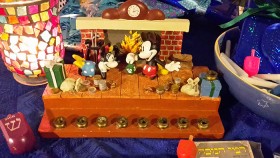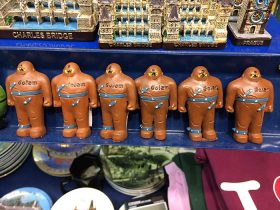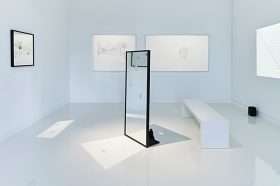They’re ubiquitous in Prague souvenir shops: clunky, mechanical golem figurines that owe their popularity to the 1951 film The Emperor and the Golem. The Czechoslovakian comedy classic, called Císařův pekař a pekařův císař in the original, was conceived by Martin Frič and Jiří Krejčík as a comedy of errors with political undertones. An irascible Emperor Rudolph II and his corrupt court are searching alternately for an elixir of youth and a recipe to turn lead into gold. But above all they want to find the legendary golem. This is the missing piece in the emperor’s cabinet of wonders and curiosities. On the search for the golem a brilliant switch takes place between Rudolf and his imperial baker, Matej. It’s an exchange from which both can profit in their different ways: → continue reading
Bread and Golems
Halftime for (the) GOLEM — What Do Our Visitors Have to Say?
Laura (23), Romania, architecture student
What is your impression of the exhibition?
The exhibition is fascinating and creepy at the same time. It makes you believe that the creatures displayed are real. Therefore, the atmosphere is very intense.
Which object or room has impressed you the most?
The room with the mirrors impressed me a lot. First, we were just playing around, which was fun. I could see myself and my friend in the mirror at the same time. But when I think of it now, it could be a metaphor for “looking beyond yourself.”
Do you know a sort of “Golem” from today?
As children, we have toys, dolls, and sometimes imaginary friends. We can talk to them and make them do what we want them to do.
Edgar (49), Germany, computer science
What was your impression of the exhibition? → continue reading
“If I were a rich mouse …”
— the Hanukkah Message?

Mice with a vice
Photo: CC-BY Michal Friedlander
I have been using the same Hanukkah lamp for nearly 20 years. I find it aesthetically-challenging and totally impractical: it is difficult to clean and the candles fall out. Yet I persist in using it because it provokes me to think. When I put the illuminated, figurative lamp on the windowsill to publicly “proclaim the Hanukkah miracle of light,” the same three questions always resurface in my mind: “Who designed this lamp?,” “What were they thinking?,” and, “Are Mickey and Minnie Mouse actually Jewish?” → continue reading

